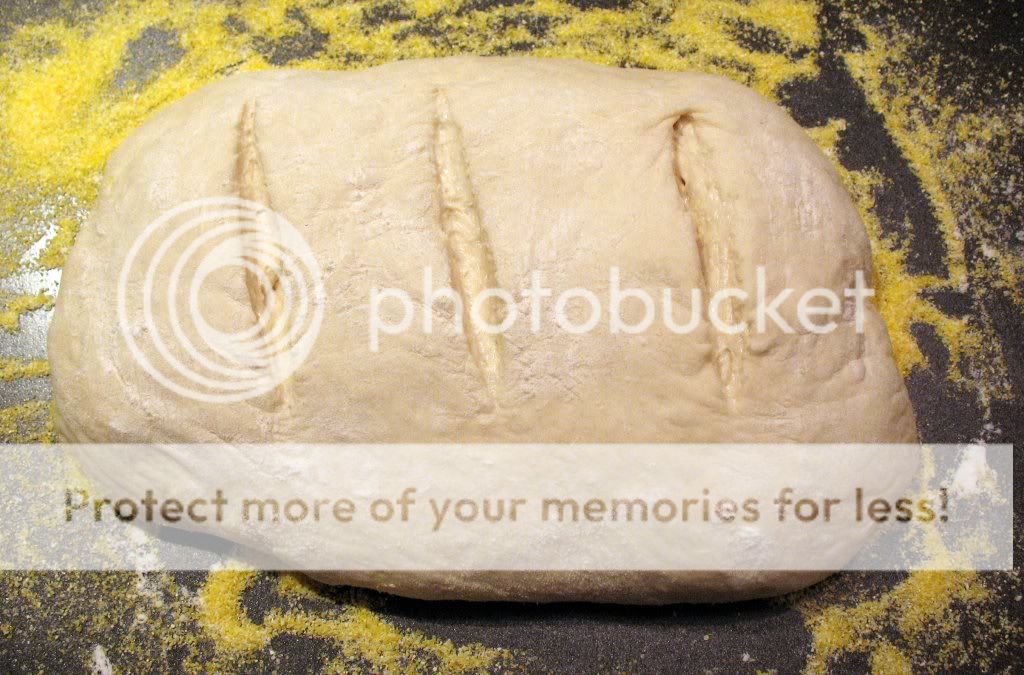Artisan Bread
December 11th, 2008 by Beth
I love bread.
Despite my love of bread, I did not try making it until I found this recipe. There was something intimidating about working with yeast (silly, I know) and I didn’t want to deal with hand-kneading bread for several minutes. Last winter, I stumbled upon a review for Artisan Bread in Five Minutes a Day by Jeff Hertzberg and Zoe Francois in the Boston Globe. Easily creating crusty no-knead artisan bread at home with a bowl and spoon? I was sold!
The central idea behind Artisan Bread in Five Minutes a Day is that “Pre-mixed, pre-risen, high moisture dough keeps well in the refrigerator.” Initially mixing the dough takes about 10 minutes or less and shaping/baking a loaf only requires 5 minutes of attended preparation time.
The book contains several dough recipes, and each of these recipes can be shaped into different kinds of loaves or enhanced with additional flavors. So far, I have only used the Master Recipe to make a basic boule. The loaves I have baked have a nicely crackled crust and an airy, moist interior.
I follow the Master Recipe quite closely. While the recipe calls for unbleached flour, I often use bleached flour because that is what I usually have on hand. It’s worth noting that book suggests using the scoop and sweep method to measure flour: gently scoop the flour and level with a knife or spatula – don’t press down. I also shape my dough into an oblong loaf, as opposed to a boule.
The Master Recipe makes enough dough for 4 1 pound loaves of artisan bread. The book claims that the dough can be refrigerated for up to two weeks, but it hasn’t lasted that long for me. For this reason, I usually halve the recipe and only make 2 loaves.
I’ve found that the dough is lighter and airier if you allow it to rise for 3-4 hours. It’s much easier to work with the dough if you refrigerate it for several hours before shaping a loaf. Regardless of when you handle the dough, it is sticky. I make sure to remove my rings and sometime spray some cooking spray on my hands.
The recipe suggests using a pizza peel coated in corn meal to move the dough into the oven. I have found that a rimless cookie sheet coated with a generous coating of flour works fine. Corn meal does make the transfer easier, but I’ve just started using it recently. While the recipe suggests working dough by hand, it’s also possible to mix it using a stand mixer.

The master recipe from Artisan Bread in Five Minutes a Day is available online, but the book goes into much more detail and provides a number of other recipes. I highly recommend it!
Artisan Bread in Five Minutes A Day: Master Recipe
Makes four 1-pound loaves
3 cups lukewarm water (about 100? F)
1 1/2 tablespoons granulated yeast (1/2 tablespoon = 1 1/2 teaspoons)
1 1/2 tablespoons kosher or other coarse salt
6 1/2 cups unsifted, unbleached all-purpose white flour
Cornmeal for the pizza peel
1.In a 5-quart bowl, mix the yeast, water and salt. Add all the flour, then use a wooden spoon to mix until all ingredients are uniformly moist. It is not necessary to knead or continue mixing once the ingredients are uniformly moist. This will produce a loose and very wet dough.

2.Cover with a lid (not airtight). Allow the mixture to rise at room temperature until it begins to collapse, about 2 hours, but no more than 5 hours.
3. After rising, the dough can be baked immediately, or covered (non completely airtight) and refrigerated up to 14 days. The dough will be easier to work with after at least 3 hours refrigeration.

4. On baking day, prepare a pizza peel by sprinkling it liberally with cornmeal to prevent the bread from sticking when you transfer it to the oven. Uncover the dough and sprinkle the surface with flour. Pull up and cut off a 1-pound (grapefruit-size) piece of dough (serrated knives are best). Store the remaining dough in the bowl and refrigerate for baking at another time.
5. Hold the mass of dough in your hands and add a little more flour as needed so it won’t stick. Create a smooth ball of dough by gently pulling the sides down around to the bottom, rotating the ball a quarter-turn as you go. While shaping, most of the dusting flour will fall off. The bottom of the loaf may appear to be a collection of bunched ends, but it will flatten out during resting and baking. Shaping the loaf this way should take no more than 1 minute.
6.Place the dough on the pizza peel. Allow the loaf to rest for about 40 minutes. It does not need to be covered. The bread may not rise much during this time.
7. Twenty minutes before baking, place a pizza stone on the center rack of the oven. If you don’t have a baking stone, use another baking sheet. Remove any upper racks. Place a broiler pan on a rack below the pizza stone or on the floor of the oven. Preheat oven to 450 F.

8. When the dough has rested for 40 minutes, dust the top liberally with flour, then use a serrated knife to slash a 1/4-inch-deep cross or tic-tac-toe pattern into the top.
9.Slide the loaf off the peel and onto the baking stone. Quickly but carefully pour 1 cup of hot water into the broiler tray and close the oven door.
10.Bake for about 30 minutes, or until the crust is nicely browned and firm to the touch. Allow the bread to cool completely, preferably on a wire cooling rack.

Tags: Artisan Bread, Boule, No-Knead Bread
